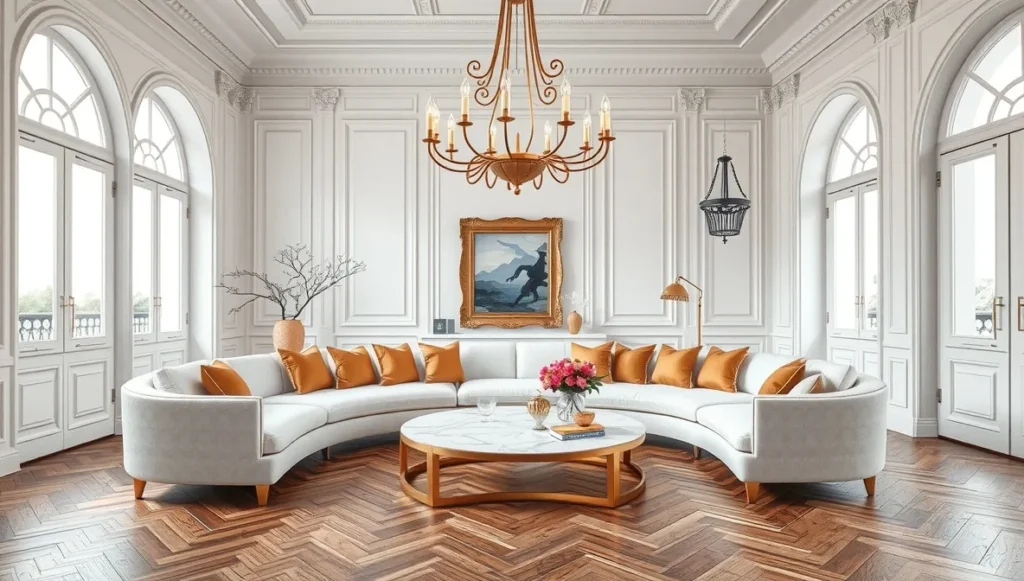- Wabi-Sabi Interior Design: The Japanese Way of Finding Beauty in Imperfection - September 6, 2025
- Japanese Zen Interior Design: Why Less Really Is More - September 4, 2025
- Modern French Interior Design: Why Everyone’s Falling in Love (And How to Bring It Home) - September 3, 2025
Table of Contents
I’ll be super honest. There was a time when I thought French interior design was just fancy furniture no one dared to sit on. You know those gold-trimmed chairs that look stunning but feel like they belong behind velvet ropes in a museum. Gorgeous? Absolutely. Livable? Not so much… or so I thought.
Then I spent three weeks in Paris back in 2012, staying in actual French homes instead of hotels. Game changer. These weren’t the over-the-top palace interiors I’d imagined. They were… well, they were just effortlessly gorgeous. Like the people living there had figured out some secret to making everything look expensive without actually trying.
Turns out, they had.
Here’s one such home I visited back then.
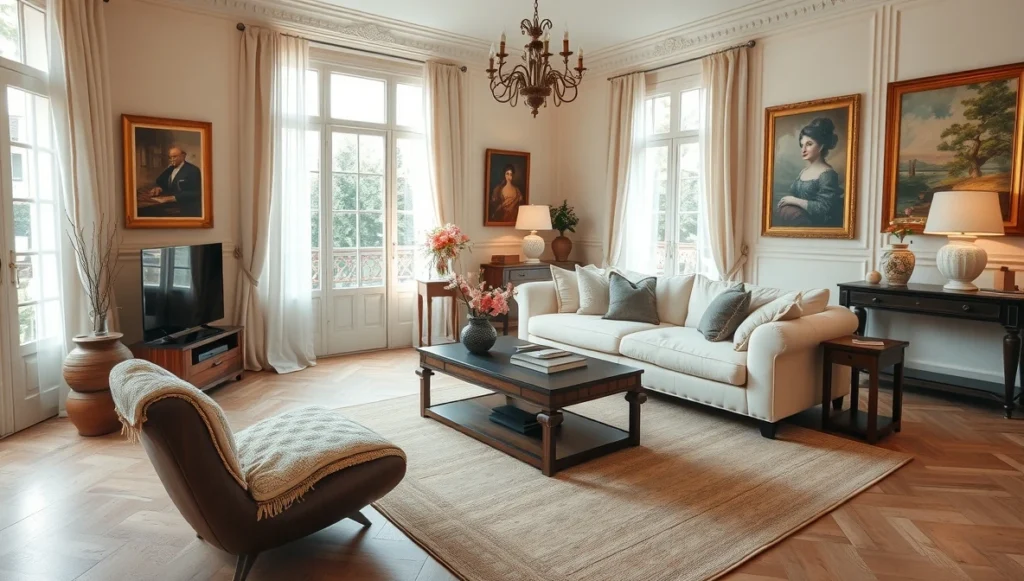
What’s All the Fuss About Modern French Style?
Modern French design is basically the cool older sister of traditional French decorating. It took all the good stuff – those perfect proportions, obsession with quality, that whole “je ne sais quoi” thing – and ditched the fussy bits that made you afraid to touch anything.
It’s sophisticated, sure, but you can actually live in it. Your kids can eat snacks on the sofa without you having a panic attack about silk upholstery. Revolutionary concept, right?
How We Got From Versailles to Livable
Traditional French interiors were designed to show off. Every room screamed “look how rich we are!” with gold leaf everywhere and furniture that was more sculpture than seating. Gorgeous? Absolutely. Practical for anyone without a staff of twenty? Not so much.
The Good Parts Worth Keeping
French designers have always understood something crucial – proportion matters more than anything else. Those soaring ceilings, massive windows, perfectly balanced rooms? That wasn’t accident. They created spaces that felt grand without crushing your soul.
Quality was non-negotiable too. French craftspeople created furniture meant to last centuries, not seasons. When you bought something French, you bought it once.
What Needed to Go
But seriously, who has time to maintain rooms full of delicate silk and carved everything? Traditional French rooms required constant care and specific knowledge about proper maintenance. Modern families needed sophistication that didn’t come with a manual.
The Modern Fix
Here’s where contemporary French design gets smart. Keep the bones – those amazing proportions, the quality obsession, the subtle luxury – but make it actually work for real people.
Fewer pieces, but better ones. Less pattern everywhere, more letting beautiful materials speak for themselves. Sophistication through restraint instead of showing off every expensive thing you own.
The Secret Ingredients
Colors That Don’t Fight Each Other
Modern French palettes live in the world of sophisticated neutrals. But we’re not talking about boring beiges here. These are complex, nuanced colors that change with the light throughout the day.
Think creamy whites that somehow feel warm instead of stark. Soft grays that don’t make you feel like you’re in a doctor’s office. Maybe the palest hint of pink or sage green, just enough to keep things from feeling cold.
I always tell clients – if you’re questioning whether a color is too bold for French style, it probably is.
Materials That Get Better with Age
The French figured out something most of us are still learning – buy things that improve over time instead of looking shabby after five years.
Limestone floors that develop this gorgeous patina. Oak furniture that gets richer and deeper as it ages. Linen curtains that become softer and more beautiful with every wash. These aren’t just materials, they’re investments in your home’s future.
Furniture That Actually Makes Sense
Modern French furniture looks formal enough for fancy dinner parties but comfortable enough that you’d actually choose to sit in it while watching TV.
Clean lines, perfect proportions, built to last. None of that trendy stuff that’ll look dated in two years. The French are playing the long game here.
Room-by-Room Reality Check
Living Rooms – Conversation Central
French living rooms are set up for actual human interaction. Wild concept in our phone-obsessed world, but stick with me.
Seating gets arranged so people can see each other’s faces. Coffee tables sturdy enough for real use but beautiful enough to anchor the whole space. Everything substantial but not overwhelming.
Lighting deserves special mention here. The French layer it like crazy – table lamps for cozy conversations, maybe something overhead for general lighting, and always candles because they make Tuesday night feel special.
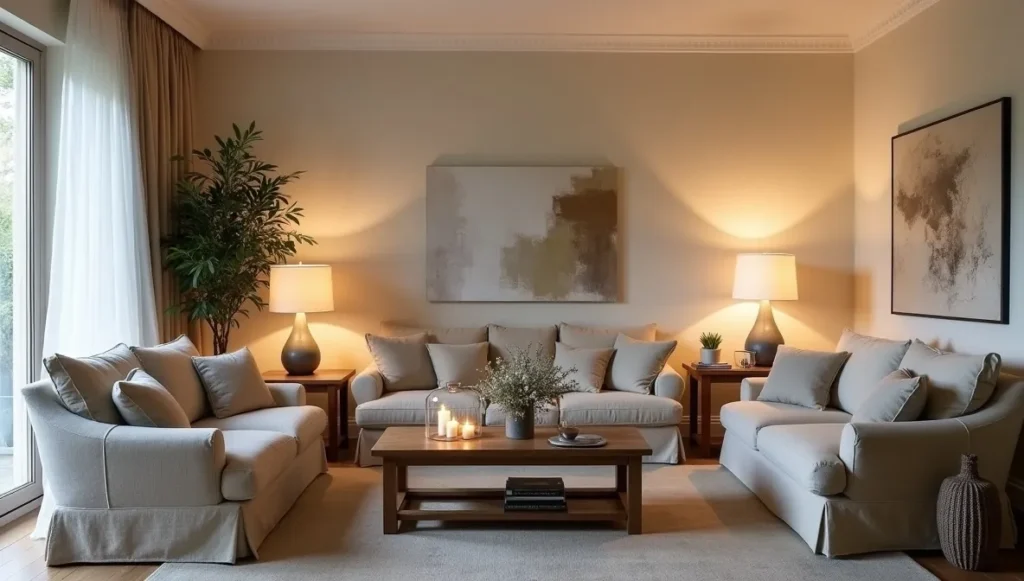
Dining Rooms – Worth the Effort
French people understand that meals are experiences worth investing in. Not every dinner needs to be an event, but your space should be ready when you want it to be one.
Big enough table for real entertaining, comfortable chairs that don’t make you want to escape after the appetizer, storage that’s beautiful enough to show off your good dishes.
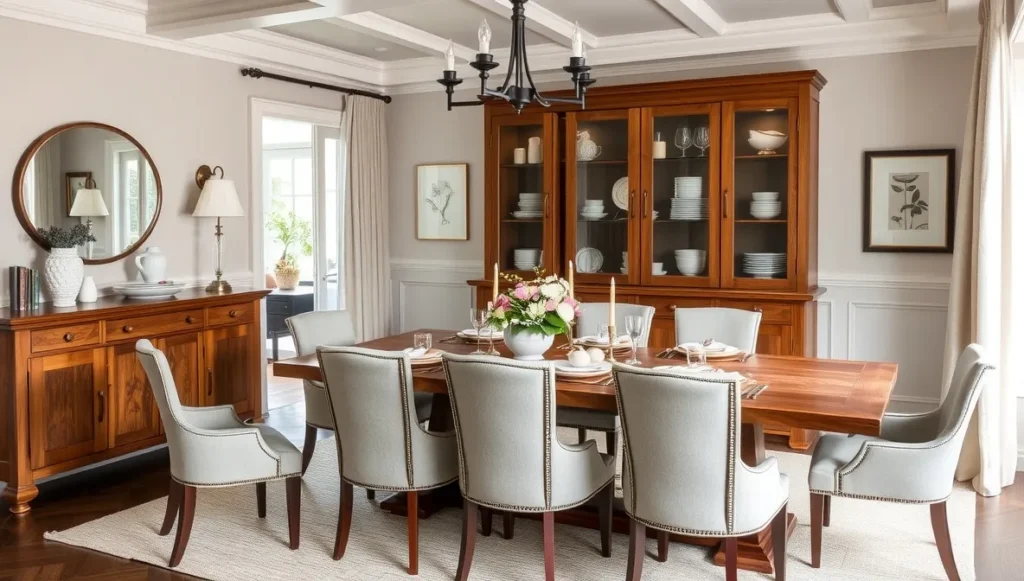
Kitchens – Beautiful and Brutal
Modern French kitchens need to handle serious cooking while looking effortless. The French don’t mess around when it comes to food preparation.
Stone countertops because they can handle anything French cooking throws at them. Cabinet design focuses on clean lines rather than fancy details. Everything functional but gorgeous.
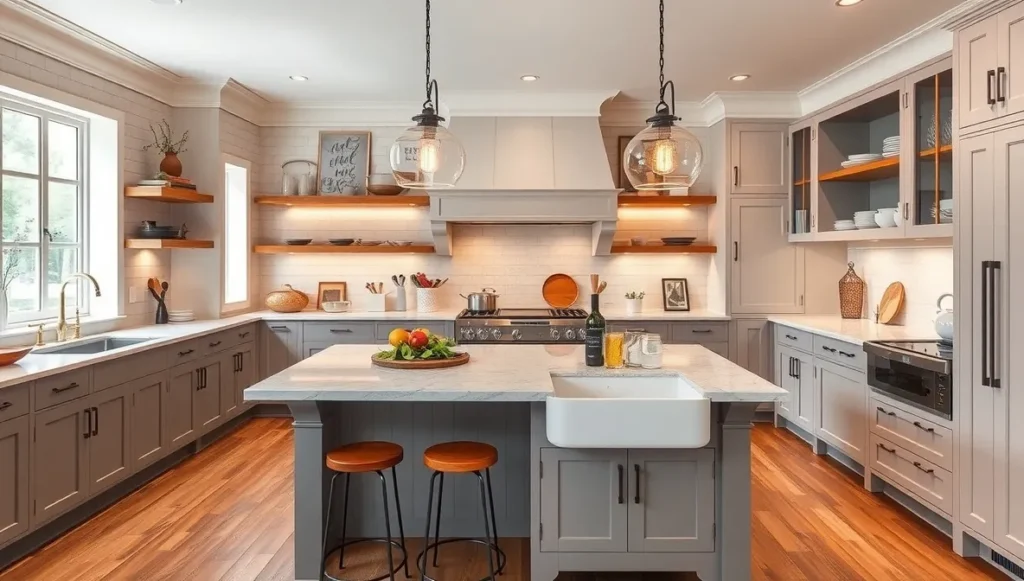
Bedrooms – Calm Luxury
French bedrooms are like stepping into a high-end spa, but one where you actually want to sleep every night.
Neutral palettes that don’t compete with rest. Textiles that feel amazing against your skin – because if you’re spending eight hours a day somewhere, it better feel good. Furniture chosen for lines and quality rather than showing off.
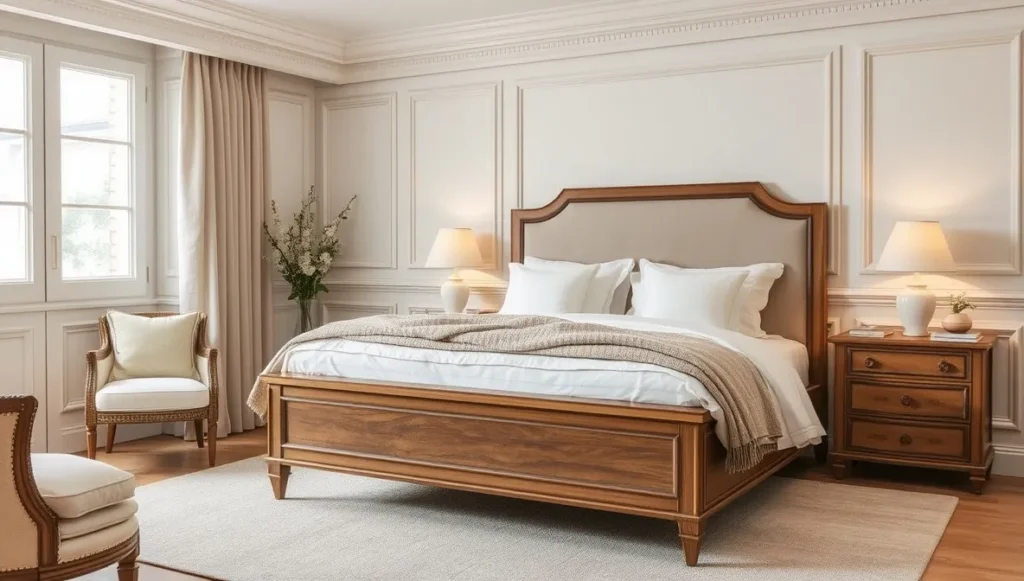
Bathrooms – Daily Luxury
Even utilitarian spaces get the French treatment. Natural stone, beautiful fixtures, attention to both function and aesthetics.
Not trying to recreate Versailles in your powder room, just making daily routines feel a little more special.
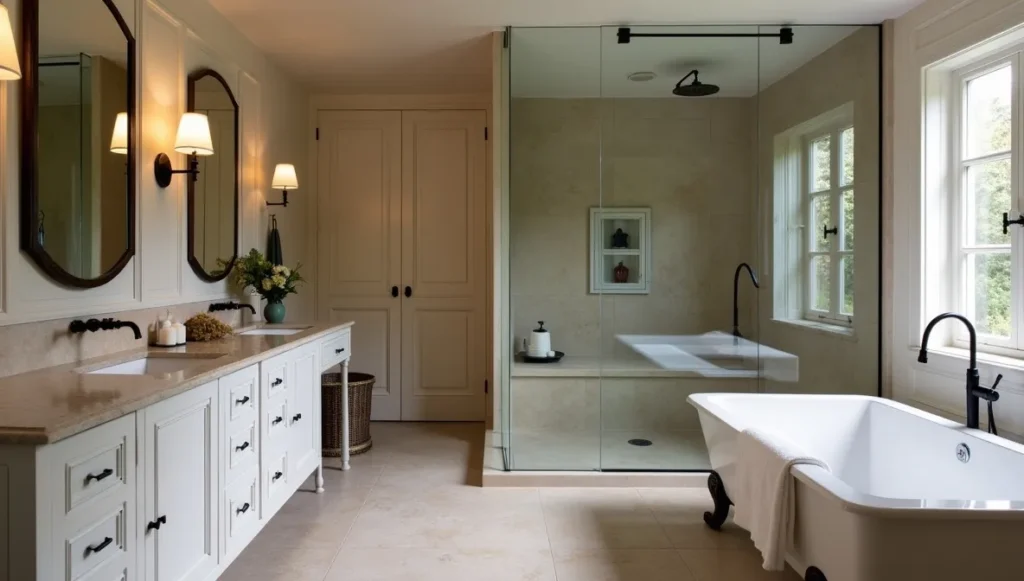
Home Offices – Work Worth Looking At
Working from home doesn’t mean sacrificing style, according to the French approach.
Beautiful desk that can handle modern work needs but doesn’t look like it belongs in a corporate office. Seating that supports long work sessions without sacrificing elegance. Storage that hides chaos while displaying a few beautiful things.
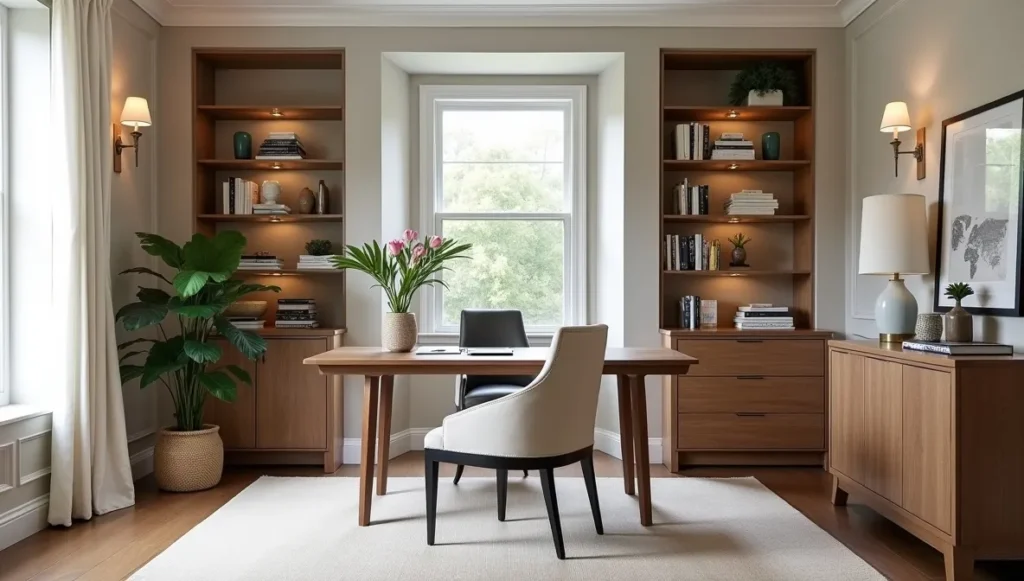
The Magic of Mixing Periods
The French do something most of us are terrified to attempt – they mix furniture from completely different time periods and somehow make it look intentional instead of confused.
Contemporary sofa next to an antique side table? Works. Modern art on walls with classical moldings? Gorgeous. The secret is consistency in quality and proportion rather than matching everything exactly.
Textiles – The French Secret Weapon
French textile game is legendary for good reason. Even in modern versions, quality matters more than flashy patterns.
Linen everywhere because it hits that sweet spot between casual and elegant. When patterns show up, they’re classic and understated – subtle stripes, small florals, maybe some traditional toile in muted colors.
Layering textures instead of competing patterns. Everything should feel considered but not overthought.
Creating the Right Mood with Light
French homes understand that lighting sets the entire mood. Never just one harsh overhead fixture doing all the work.
Multiple sources at different heights create depth and warmth. Table lamps, wall sconces, maybe a beautiful chandelier, and always candles because they make everything look better.
What Usually Goes Wrong
After years of helping people achieve French style, I’ve seen the same mistakes repeatedly:
Going overboard with ornate stuff – Modern French is about restraint. Pick your special pieces carefully.
Sacrificing comfort for looks – If it’s not comfortable, it’s not truly French. Everything should serve both beauty and function.
Using flat, lifeless neutrals – French neutrals have warmth and depth. Avoid anything that feels sterile or cold.
Ignoring proportion – This is crucial. Furniture needs to relate properly to room size and architectural features.
Getting the Look Without Breaking the Bank
French style doesn’t require château money:
Invest in anchor pieces – One beautiful sofa or solid dining table creates more impact than lots of small accessories.
Hunt vintage markets – French style mixing old and new means authentic pieces exist at every price point.
Textile upgrades work magic – Quality linen curtains or beautiful bedding can transform spaces affordably.
Paint creates instant transformation – Right neutral colors establish that sophisticated French backdrop anywhere.
Why It’s Actually Sustainable
Modern French design accidentally supports sustainable living. Emphasis on quality over quantity means buying less but better. Preference for natural materials means choosing things that age beautifully.
Love for vintage and antique pieces means giving old furniture new life instead of constantly buying new stuff.
Making It Work Anywhere
French style adapts surprisingly well to different climates and locations. The neutral foundation works everywhere, natural materials translate globally.
Warmer climates can focus more on linen and lighter textures. Colder areas add cashmere and wool. Same principles – quality, proportion, sophisticated restraint.
Starting Your French Style Journey
Want to begin? Start with paint in beautiful, complex neutrals. Add quality textiles through curtains or pillows. Look for furniture with classic proportions rather than trendy details.
Be patient. French style develops slowly, each piece chosen carefully rather than rushing to fill every corner. It’s about creating spaces that feel collected over time.
Remember – you’re not trying to recreate a Parisian apartment exactly. You’re capturing that effortless elegance and making it work for your actual life.
The best French-inspired homes feel sophisticated but never stuffy, elegant but completely livable. Every day feels a little more special, simple meals become celebrations, and you start understanding why the French seem to have figured out something the rest of us are still learning.
Done right, these homes feel both timeless and contemporary – spaces where that particular French art of living well becomes part of your daily reality, not just something you admire from afar.
